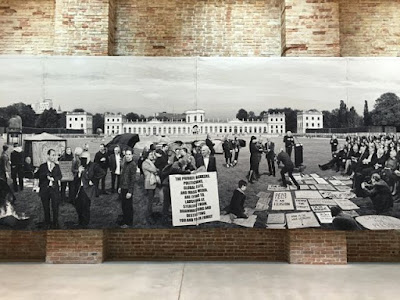Venice: Punta della Dogana – Accrochage Exhbition. This
beautiful exhibition must not be missed, until November 20 at Punta della
Dogana, which in itself is a beautiful space. Accrochage, curated by Caroline
Bourgeois, is an experiment based on a single, simple rule: select eighty
works, which have never been shown since they became part of the Pinault
Collection and underline the artist’s search and creative process, not the
work’s aesthetic. In other words, "Accrochage" focuses on how rather than why these works were created. Notwithstanding
their radical diversity, these works share a formal simplicity, a suppressed
tension that amplify the space of the other, that is of the spectators. This
freedom given by the exhibits is the aim of this exhibition. Its title
“Accrochage” (hanging-up) is deliberately neutral, unobtrusive and delivers a
simple, direct message: look!
Sol LeWitt - Wall
Drawing #343C - 1969-1998
In LeWitt’s 1967 manifesto, “Paragraphs on
Conceptual Art”, he stated that the creation of a work can be delegated to
others, as the creative process is often more interesting than the final
result. During these years, LeWitt began to create his famous Wall drawings on
the walls of museums and galleries, designed drawings that adapt to the surrounding
architecture, redefining the spatial and perceptive relationships. LeWitt made
some of these drawings himself, while others were done by assistants. Since his
death, in 2007, the drawings are created the supervision of his studio and his
daughter Sofia LeWitt. The creation of Sol LeWitt’s works follow a rigorous
procedure that excludes all emotional involvement, in contrast to the abstract
expressionism and informal art of the 1960s.
DeWain Valentine – Diamond Column – 1975
From when he was young, DeWain
Valentine worked as a polisher in the car industry; this experience led to him
developing a strong interest in reflective, shiny surfaces and industrial
processes. Seduced by West Coast artists such as Larry Bell, Craig Kauffman and
Kenneth Price, in 1965 he moved to Los Angeles, and joined the Light and Space
movement. Valentine is known for his geometrically essential casts, made from
translucent resin. Valentine was in fact pioneered the use of plastic and
industrial resin in art: the surfaces of his monumental sculptures reflect and
distort light and the surrounding space.
Pier Paolo Calzolari – Senza titolo (Materassi) – 1970
A symbolic figure for contemporary
Italian art, Pier Paolo Calzolari in the 1960s, was connected to the Arte
Povera artists: his text ‘The Ideal House’ is considered one of the movement’s
key statements. During those years, he created a series of works with natural
materials and elements such as metals, vegetables, minerals, fire and ice.
Calzolari’s glacial frozen structures developed a light frost over their
surfaces as time passed, as the material went through a process of alchemical
transformation. In all the artist’s work, the objects undergoes or produces
change, which becomes the central element of a dream, mystery or drama, and
introduces a theatrical dimension to the work.
Fabio Mauri – Schermo – 1970
Fabio Mauri (1926-2009) was one of
the great Italian avant-garde masters of the 1960s. Despite having grown up in
an Italy impacted by the Second World War and Fascism, Mauri has always
inhabited an intellectual environment, mixing with writers such as Italo
Calvino and Umberto Eco, and artists like Pier Paolo Pasolini and Jannis
Kounellis. His works emerge from a strong sense of social responsibility,
showing continuous political commitment against Fascism, and invite the viewer
to cast a critical eye on their experience of reality. As cinema and television
become part of daily life in the 1950s, Fabio Mauri came to regard the screen
as the world’s principal ‘symbolic form’, a sign of the new media civilization.
In 1957, he began his series ‘Screens’: a series of empty screens corresponding
with interior spaces are represented on the canvas, which invite possible
projections from the viewers. Mauri continued to make works on the theme of
memory and pretense until the 1970s, when he progressed from painting to
performance. The artist crossed the limits of the canvas, transferring his
interest from painting to action, but continued to consider art as a meeting
point between individual destiny and history.
Goshka Macuga – Of What Is,
That It Is; That It Is Not 1 and 2 – 2012
Polish artist Goshka Macuga was born
in 1967 and today lives and works in London. Curator, collector, researcher and
set designer, Macuga is a multidisciplinary arist who combines different
expressive forms in complex narrative works that are full of meaning. Building
a bridge between historic documentation and truth, Macuga draws out affinities
and connections, revealing things that would not normally be seen. In her work,
history, politics, sociology and ethnography are combined with personal stories
and references to other artists, enabling her to create works with
multi-layered meanings.
Peter Dreher – Tag um Tag Guter Tag (Every
day and night) – 1974-2013
German
artist Peter Dreher was born in 1932. Profoundly influenced by the atrocities
of the Second World War and the Nazi regime, he considers painting an escape
and refuge. Whether painting still life, pots, building facades in New York or
abstract motifs, the subjects of his paintings all result from careful
observation of light and transparency. In 1974, he made the first painting of
what would become his life project: the series, Tag um Tag Guter Tag. Every day and night, Dreher paints, in
a hyper-realistic way, the same empty glass placed on a table in front of a
white wall. He has made more than 3000 representations of this glass, following
one simple rule: once the painting has been started, it has to be finished on
the same day. Dreher’s work is like a diary in which the artist records a
meditative exercise with which he dismantles the rules of painting, deepening
the relationship between what we see and what we know.
Pin It







